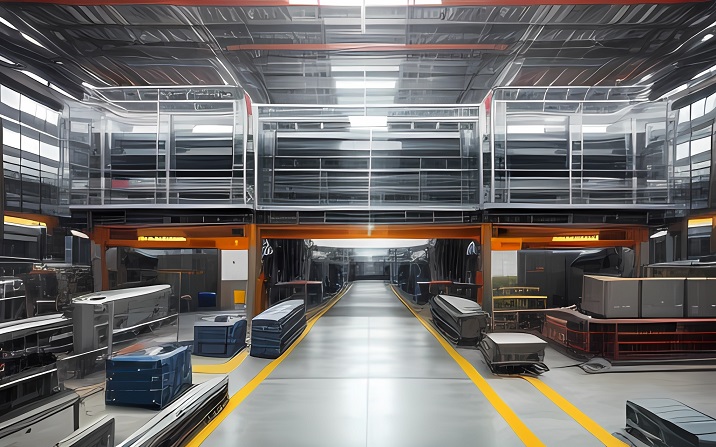Long River Technology - Manufacturing Execution System
MES (Manufacturing Execution System) is an information system used to monitor and manage the manufacturing process. Its functions usually include: manufacturing management, BOM configuration management, manufacturing accounting and production kanban.

Manufacturing management refers to the process of planning, organizing, coordinating and controlling production activities, with the aim of improving production efficiency and quality while reducing costs and risks.
The main contents of manufacturing management include the following aspects:
1. Production plan management: According to customer orders, forecast demand, etc., formulate production plans, determine production tasks, production time and production quantity, etc. The MES system can receive the production plan from the ERP system and decompose it into detailed production tasks, which are assigned to each work center or production line.2. Production scheduling management: According to the production plan, arrange the production schedule, determine the production time and sequence of each process, optimize the production process, and improve production efficiency.3. Production execution control: The MES system can monitor the production process in real time, including production progress, production quality, equipment status, etc., and provide real-time data and alarms to help production managers find and solve problems in a timely manner.4. Production site management: manage the production site, including equipment maintenance, material management, personnel scheduling and production progress monitoring.5. Production quality management: monitor and manage the quality of the production process to ensure that the product quality meets the requirements and improve the product qualification rate.6. Production cost control: Cost control of the production process, including raw material costs, labor costs, manufacturing costs, etc., to achieve cost optimization and control.7. Production equipment management: manage production equipment, including equipment maintenance, maintenance and replacement, etc., to ensure the normal operation of equipment and improve equipment utilization.8. Production personnel management: manage production personnel, including personnel recruitment, training and performance evaluation, etc., improve employee skills and quality, and improve production efficiency and quality.9. Production data analysis: MES system can perform statistics, analysis and visualization of production data, including production efficiency, product quality, equipment utilization rate, etc., to help enterprises understand production status and improve production process.10. Production scheduling management: MES system can dynamically adjust production scheduling and optimize production resources and efficiency according to production plan and actual production situation.11. Production document management: MES system can manage various documents in the production process, including process documents, operation manuals, quality records, etc., to ensure the specification and standardization of the production process.12. Production authority management: MES system can set different operation authority to ensure the safety and controllability of the production process.
Through the MES system, enterprises can optimize the production process, improve production efficiency and product quality, and reduce production costs and risks. Through production and manufacturing management, enterprises can optimize the production process, improve production efficiency and product quality, reduce costs and risks, and achieve sustainable development.

BOM configuration management refers to the process of configuring and managing the product BOM (Bill of Materials) to ensure the correct composition and configuration of the product. BOM configuration management is one of the important links in manufacturing management, and it has an important impact on the production activities and supply chain management of enterprises. The main contents of BOM configuration management include the following aspects:
1. BOM structure analysis: analyze the BOM structure, determine the composition and configuration relationship of the product, identify the relationship between the parent part and the component part, and determine the unit's usage and other attributes.2. BOM creation and maintenance: According to product requirements and design requirements, create and maintain BOM to ensure the accuracy and completeness of BOM.3. BOM review and change management: review and change management of BOM to ensure the legality and correctness of BOM. When it is necessary to modify the BOM, it needs to go through the corresponding review and change process to ensure the accuracy and timeliness of the modification.4. BOM use and release: use BOM for production planning, material demand accounting, inventory management, etc., and release BOM information as needed for use by relevant departments and personnel.5. BOM version management: manage the BOM version to ensure that the differences and change records between different versions are clearly traceable to avoid confusion and mistakes.6. BOM optimization and improvement: According to the actual production situation and needs, optimize and improve the BOM to improve production efficiency and product quality, and reduce costs and risks.
Through BOM configuration management, enterprises can ensure the correctness of product composition and configuration, improve production efficiency and product quality, reduce costs and risks, and achieve sustainable development.

Manufacturing accounting is one of the important financial activities of manufacturing enterprises. It aims to calculate various costs and expenses in the production process, including direct materials, direct labor, manufacturing expenses, etc., to determine the production cost and profitability of products. The following are the main contents of manufacturing accounting:
1. Cost accounting object: Determine the cost accounting object, that is, the type and batch of products produced, and the object that bears the expenses determined for the collection of production expenses.2. Cost items: Classify product costs, including direct materials, direct labor, manufacturing costs, etc.3. Cost accounting procedure: According to the prescribed cost accounting procedure, collect, allocate and calculate various costs and expenses in the production process, and finally obtain the production cost and profitability of the product.4. Cost accounting method: According to the actual situation and needs of the enterprise, choose the appropriate cost accounting method, such as standard cost method, actual cost method, activity-based cost method, etc.5. Cost accounting cycle: According to the prescribed cost accounting cycle, calculate and report the product cost, such as month, quarter, year, etc.6. Cost analysis and control: analyze and control product costs, find out cost differences and room for improvement, and propose cost control measures to reduce production costs and increase profitability.
Through production and manufacturing accounting, enterprises can grasp the cost and expenses in the production process, understand the profitability and market competitiveness of products, and provide a basis for business decision-making.

Production Kanban refers to a tool used for production management, which is used to indicate processing instructions on the production line and transmit production information. Production Kanban usually includes the following information:
1. Production planning: determine what products to produce, production quantities and delivery deadlines, etc.2. Processing ticket: Instructs how to process a certain process, including processing quantity, processing time, operator, etc.3. Bill of Materials: Lists the required materials and their quantities, as well as the supply and inventory of the materials.4. Equipment maintenance and calibration: record the maintenance and calibration of equipment to ensure the normal operation of equipment and the quality of products.5. Quality management: record the quality of the product and the measures taken, so as to track and improve the product quality.6. Incoming goods inspection: Incoming goods are inspected to ensure that the quality and quantity of the goods meet the requirements.7. Production site management: It is used to indicate the work flow and production situation of the production personnel on site, including production progress, equipment status, personnel arrangement, etc.
Through production kanban, enterprises can better manage the production process, improve production efficiency and product quality, and at the same time reduce production costs and waste.